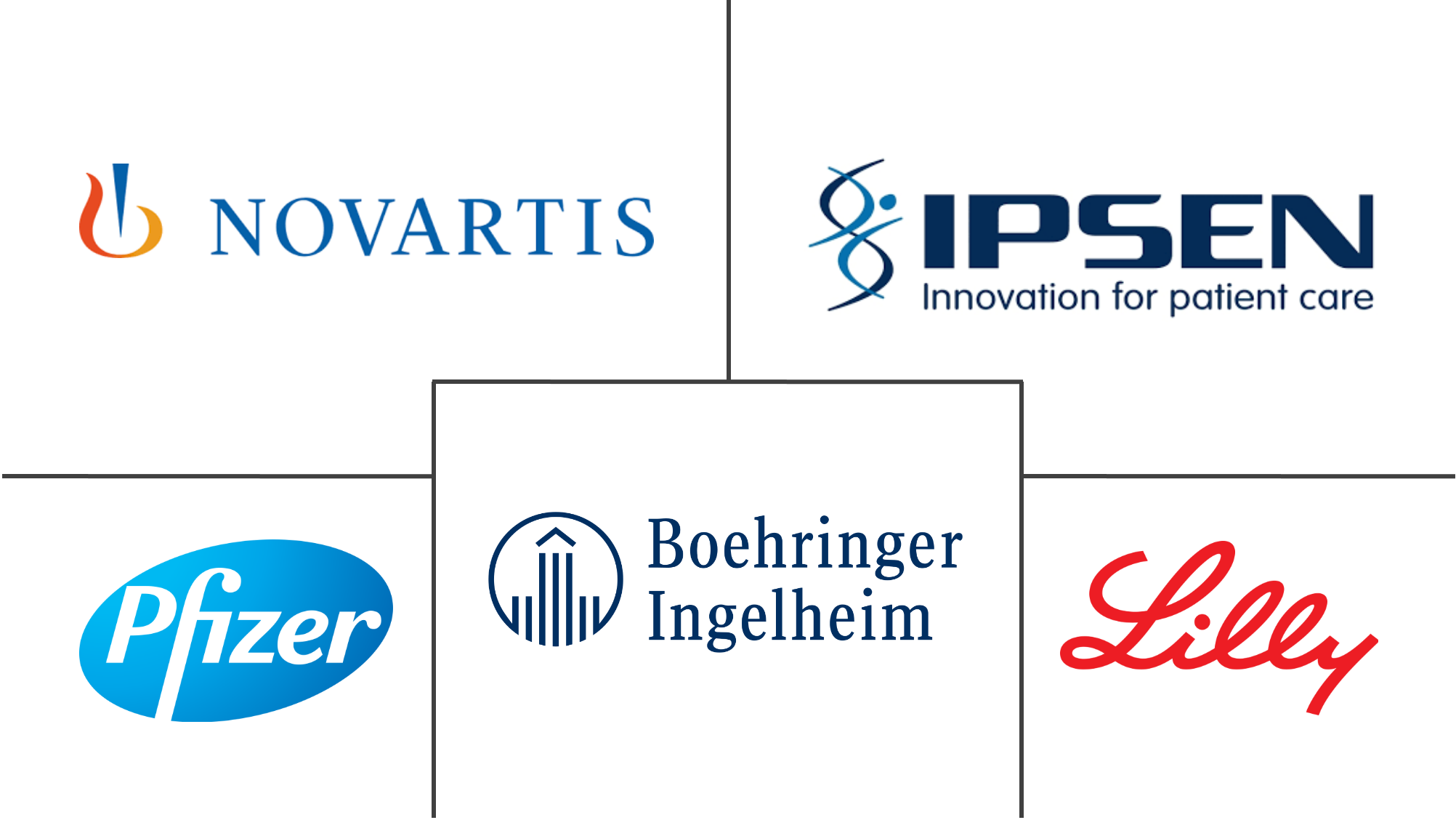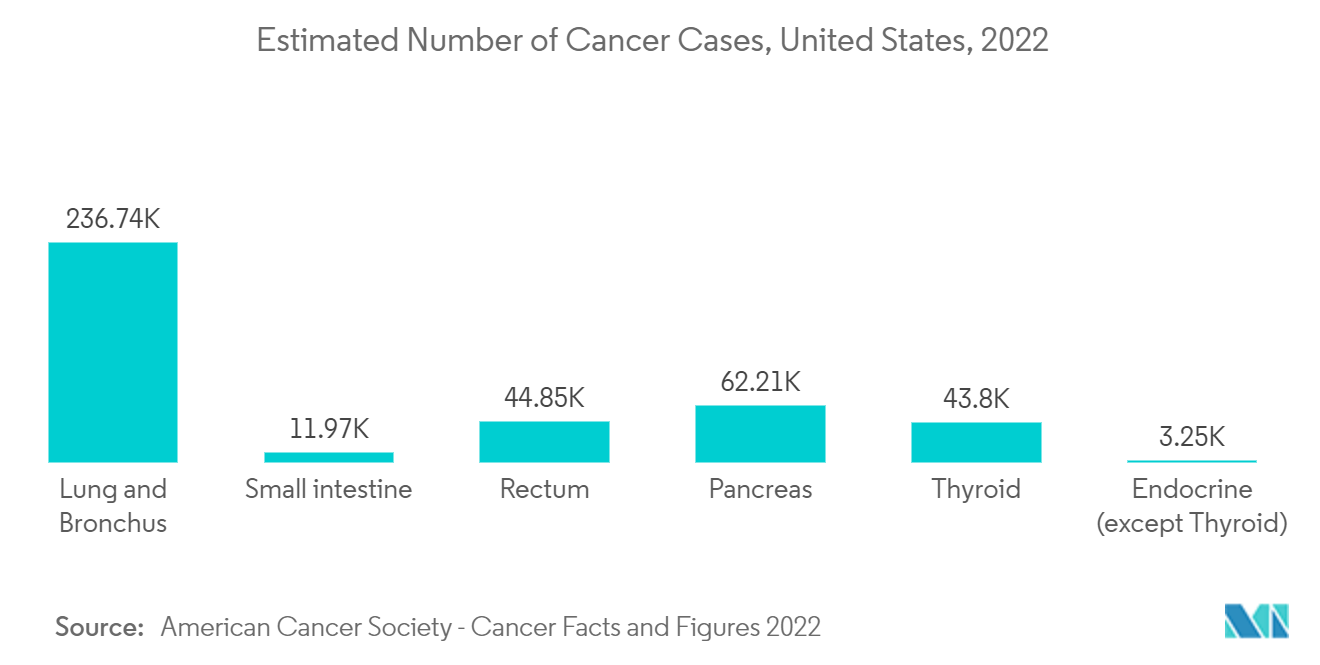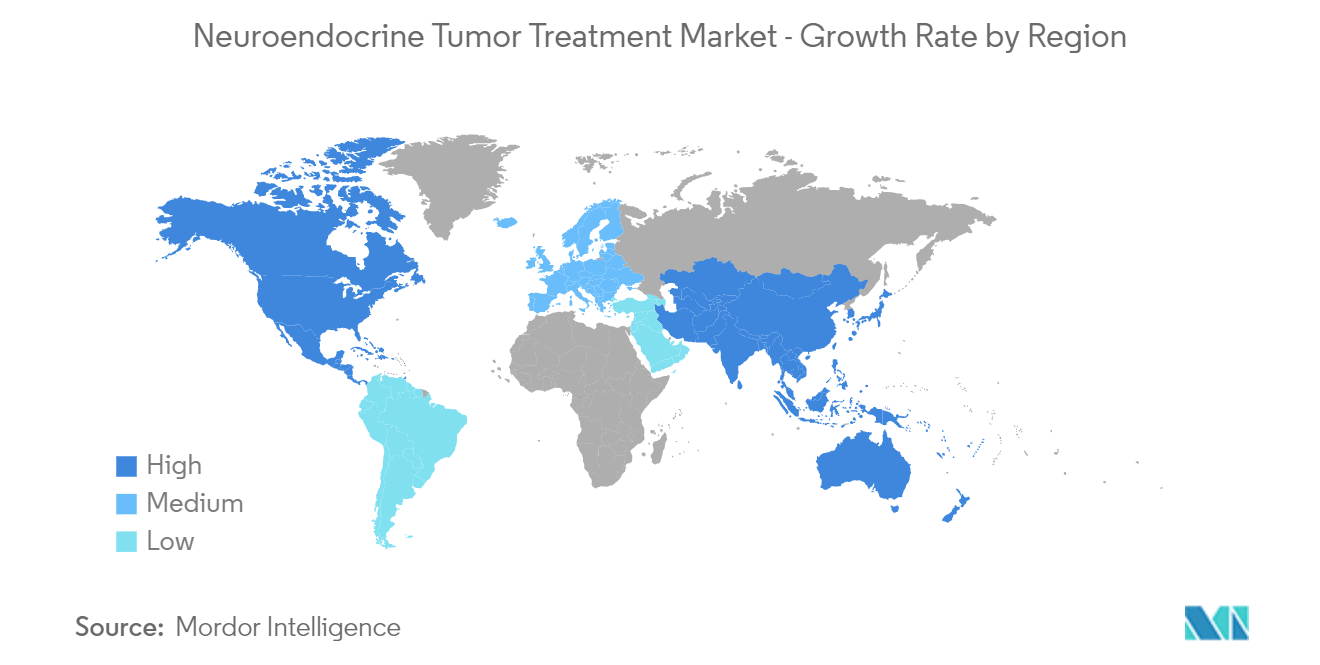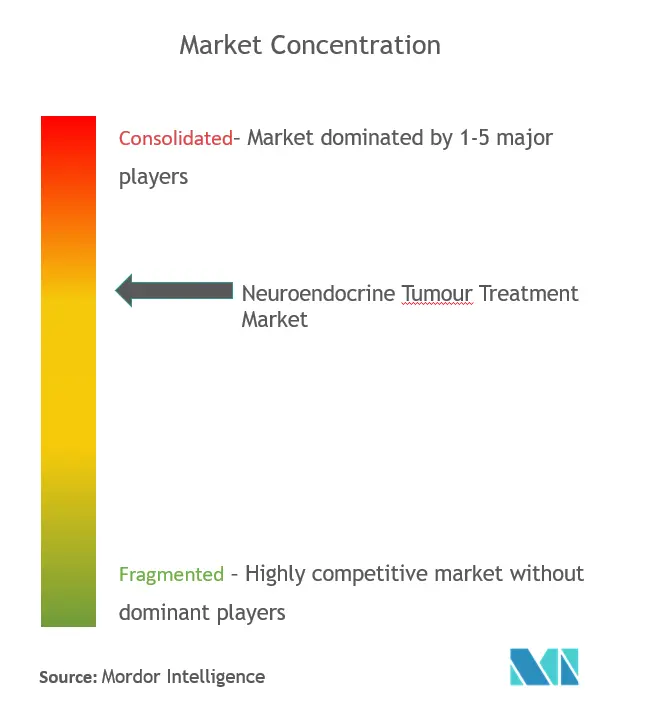Neuroendocrine Tumor Treatment Market Size

| Study Period | 2019 - 2029 |
| Base Year For Estimation | 2023 |
| Forecast Data Period | 2024 - 2029 |
| CAGR | 10.00 % |
| Fastest Growing Market | Asia Pacific |
| Largest Market | North America |
Major Players
*Disclaimer: Major Players sorted in no particular order |
Neuroendocrine Tumor Treatment Market Analysis
The Neuroendocrine Tumor Treatment Market is projected to register a CAGR of 10% during the forecast period (2022 - 2027).
The ongoing outbreak of COVID-19 showed an impact on the Neuroendocrine Tumor Treatment market because hospital and healthcare services were significantly reduced due to social distancing measures taken by governments across the globe. Moreover, the COVID-19 pandemic not only affected the global economy but also showed a huge impact on the functioning of general hospital care for non-COVID-19 patients in hospitals across the globe. An article titled 'Impact of the COVID-19 pandemic on neuroendocrine tumour services in England' published in the journal of Endocrine in January 2021 indicated that during the COVID-19 pandemic, there were particular concerns regarding the specialist tumor treatment services. The article stated that the major disruption in specialist neuroendocrine treatment services included relevantly increased waiting times for both new and follow-up appointments, with an especially substantial delay of follow-up appointments. The lag in other treatment services during the COVID-19 pandemic greatly impacted the neuroendocrine tumor treatment market.
The neuroendocrine tumor treatment market is driven by the factors such as the growing prevalence of neuroendocrine cancer, technological advancements in the field of neuroendocrine tumor treatment, and the rise in the number of government initiatives. An article titled 'Advances in the Diagnosis and Therapeutic Management of Gastroenteropancreatic Neuroendocrine Neoplasms (GEP-NENs)' published in the Journal of Cancers in April 2022 indicated the occurrence of neuroendocrine have been largely increasing in the past three to four decades. Also, there has been an increase in the innovations in the treatment methods for neuroendocrine treatment including somatostatin analogs, INF α, Radionuclide Treatment, Transarterial treatment, Targeted therapy, immunotherapy, CAR-T-Cell therapy, bispecific antibodies, vaccines, Cytotoxic Chemotherapy of Highly Differentiated and Low Differentiated G1 and G2 GEP NETs. The rising number of innovative treatments for the neuroendocrine tumor in the recent years have significantly improved the growth of the neuroendocrine tumor treatment in recent years.
The Department of Health of Commonwealth of Australia in January 2022 released a grant of USD 63.4 million for the rare cancers and rare diseases research under the 2021 Rare Cancers, Rare Diseases and Unmet Need (RCRDUN) grant opportunity. Specifically, the Flinders University received a funding of USD 2,374,220.10 for the project 'Implementing a Nurse-Enabled, Shared-Care Model to Address Unmet Needs of People with Neuroendocrine Tumours: the AUS-NET Trial'. The investments in the rare cancer treatment studies are a part of the long-term national health plan of the Australian government. Such investments by various government organizations are likely to add to the growth of the neuroendocrine tumor treatment market in the forecast period.
However, the high cost of neuroendocrine tumor treatment methods along with the lack of awareness among people are hindering the growth of the studied market.
Neuroendocrine Tumor Treatment Market Trends
This section covers the major market trends shaping the Neuroendocrine Tumor Treatment Market according to our research experts:
The Somatostatin Analogs (SSAs) Segment is Expected to Hold a Major Market Share in the Neuroendocrine Tumor Treatment Market.
The Somatostatin Analogs (SSAs) hold the major segment in the Neuroendocrine Tumor Treatment market. The Somatostatin Analogs (SSAs) are found to be the widely drugs used for the treatment of neuroendocrine carcinoma as they control cancer growth, symptoms, and target biomarkers. They are accounted for the largest revenue share owing to safe treatment procedure offered by SSAs.
SSAs are found to be generally used to treat patients who are resistant to radiation therapy and surgery. Many SSAs are thus currently under clinical trial phase and waiting for approval, hence the market is expected to witness high growth over the forecast period. An article titled 'Comparing Somatostatin Analogs in the Treatment of Advanced Gastroenteropancreatic Neuroendocrine Tumors' published in the Journal of Oncology in January 2022 discussed the action of two somatostatin analogs, in the treatment of neuroendocrine tumors. The article indicated that the somatostatin analogs were one of the most preferred treatment methods for neuroendocrine tumors. The rising prevalence of use of somatostatin analogs for neuroendocrine tumor treatment are adding to the growth of the studied market.
Another article presented in the journal of Patient-Reported Outcomes in September 2021 titled 'Patients' satisfaction with long-acting injectable somatostatin analog therapy for neuroendocrine tumors' performed a qualitative survey that studied the patient experiences with somatostain analog therapy. The study indicated that satisfaction with Long Acting SSA injection is high among patients in the treatment. Such advantages of the somatostatin analogs are expected to add to the grwoth of the market in the forecast period.
Several key market players have been focusing on the researcvh and development of somatostatin amalogs for neuroendocrine tumor treatment. In March 2022, Amyrt Pharma plc reported that the successful bioavailability study for Mycapssa (octreotide capsules) in a planned Phase 3 study in the treatment of carcinoid symptoms associated with Neuroendocrine Tumors (NET). The study demonstrated that doses of Mycapssa up to 80mg resulted in the desired bioavailability and dose proportionality with an acceptable safety and tolerability profile. The rise in the research and development of such somatostatin analogs for the treatment of neuroendocrine tumor are adding to the growth of the studied segment in the forecast period.

North America is Expected to Hold a Significant Share in the Market and Expected to do Same in the Forecast Period (2022 – 2027).
The rise in the adoption of highly advanced techniques and systems in the neuroendocrine tumor treatment field and the technological advancements made in cancer therapeutics is expected to boost the growth of the market in the North American region. The high awareness among the population on the availability of innovative therapeutics in neuroendocrine tumor treatment in the market contributes to the high market growth in the region.
The rising number of neuroendocrine cancer cases in the North American region is adding to the growth of the neuroendocrine tumor treatment market. According to the American Society of Clinical Oncology Neuroendocrine Tumor Statistics updated in February 2022, more than 12,000 people in the United States are diagnosed with a Neuroendocrine Tumor each year, and approximately 175,000 people are living with the diagnosis. The article also stated that the number of cases has been in the rise in recent years.
According to the National Center for Advancing Translational Sciences - Genetic and Rare Diseases Information Center data updated in November 2021, there were around 3,000 to 30,000 people in the United States affected by carcinoid tumor, which usually develops in the gastrointestinal tract or the lungs. The wide prevalence of the neuroendocrine cancer cases in the region is expected to add to the market growth.
The recent approval of neuroendocrine tumor treatment drugs by the Food and Drug Administration in the United States region is adding to the growth of the studied market in the forecast period. For instance, in August 2021, the United States Food and Drug Administration approved belzutifan (Welireg), a hypoxia-inducible factor inhibitor for adult patients with von Hippel-Lindau disease who require therapy for associated renal cell carcinoma, central nervous system hemangioblastomas, or pancreatic neuroendocrine tumors, not requiring immediate surgery. The rise in the approval of such drugs is adding to the growth of the neuroendocrine treatment market in the United States region in the forecast period. There are also supportive insurance policies in this region facilitating neuroendocrine treatment, such as Medicare, Medicaid, and Tricare that helps in driving the overall growth of the market.
Thus the increasing necessity for Neuroendocrine Tumor Treatment technology coupled with increasing investment in the health care department is known to propel the growth of the market in this region.

Neuroendocrine Tumor Treatment Industry Overview
The key players are found undertaking strategies such as product launches, regional expansion, partnership and distribution agreements, to strengthen their market position. There are also various companies that are found focusing on organic growth strategies product approvals and others such as patents and events. The inorganic growth strategies activities witnessed in the market were acquisitions, and partnership & collaborations. Some of the companies which are currently dominating the market are Pfizer Inc., Novartis AG, Ipsen, Boehringer Ingelheim International GmbH, Eli Lilly & Company, among others.
Neuroendocrine Tumor Treatment Market Leaders
-
Pfizer Inc.
-
Novartis AG
-
Ipsen
-
Boehringer Ingelheim International GmbH
-
Eli Lilly & Company
*Disclaimer: Major Players sorted in no particular order

Neuroendocrine Tumor Treatment Market News
- In June 2022, Ariceum Therapeutics launched with EUR 25M funding for the diagnosis and systemic targeted radiation therapy to advance the treatment of low- and high-grade neuroendocrine cancers.
- In March 2022, Ipsen invested in a new state-of-the-art electronic autoinjector for Somatuline Autogel / Somatuline Depot (lanreotide), to deliver further innovation in the class with the aim of improving administration and the injection experience for patients. The autoinjector is designed to improve the patient experience for people living with gastroenteropancreatic neuroendocrine tumors, carcinoid syndrome or acromegaly.
Neuroendocrine Tumor Treatment Market Report - Table of Contents
1. INTRODUCTION
- 1.1 Study Deliverables
- 1.2 Study Assumptions
- 1.3 Scope of the Study
2. RESEARCH METHODOLOGY
3. MARKET DYNAMICS
- 3.1 Market Overview
-
3.2 Market Drivers
- 3.2.1 Increasing Prevalence of Neuroendocrine Carcinoma
- 3.2.2 Technological Advancements
- 3.2.3 Rising Number of Government Initiatives
-
3.3 Market Restraints
- 3.3.1 High Cost of Development
- 3.3.2 Lack of Awareness Among People
-
3.4 Porter's Five Force Analysis
- 3.4.1 Threat of New Entrants
- 3.4.2 Bargaining Power of Buyers/Consumers
- 3.4.3 Bargaining Power of Suppliers
- 3.4.4 Threat of Substitute Products
- 3.4.5 Intensity of Competitive Rivalry
4. EXECUTIVE SUMMARY
5. MARKET SEGMENTATION
-
5.1 By Products
- 5.1.1 Somatostatin Analogs (SSAs)
- 5.1.2 Targeted Therapy
- 5.1.3 Chemotherapy
- 5.1.4 Others
-
5.2 By Indication
- 5.2.1 Lungs
- 5.2.2 Pancreas
- 5.2.3 Gastrointestinal
- 5.2.4 Others
-
5.3 By End User
- 5.3.1 Hospitals
- 5.3.2 Clinics
- 5.3.3 Others
-
5.4 Geography
- 5.4.1 North America
- 5.4.1.1 United States
- 5.4.1.2 Canada
- 5.4.1.3 Mexico
- 5.4.2 Europe
- 5.4.2.1 Germany
- 5.4.2.2 United Kingdom
- 5.4.2.3 France
- 5.4.2.4 Italy
- 5.4.2.5 Spain
- 5.4.2.6 Rest of Europe
- 5.4.3 Asia Pacific
- 5.4.3.1 China
- 5.4.3.2 Japan
- 5.4.3.3 India
- 5.4.3.4 Australia
- 5.4.3.5 South Korea
- 5.4.3.6 Rest of Asia-Pacific
- 5.4.4 Middle East and Africa
- 5.4.4.1 GCC
- 5.4.4.2 South Africa
- 5.4.4.3 Rest of Middle East and Africa
- 5.4.5 South America
- 5.4.5.1 Brazil
- 5.4.5.2 Argentina
- 5.4.5.3 Rest of South America
6. COMPETITIVE LANDSCAPE
-
6.1 Company Profiles
- 6.1.1 Boehringer Ingelheim International GmbH
- 6.1.2 Bristol-Myers Squibb
- 6.1.3 Eli Lilly & Company
- 6.1.4 F. Hoffmann-La Roche Ltd.
- 6.1.5 Ipsen
- 6.1.6 Novartis AG
- 6.1.7 Pfizer Inc.
- 6.1.8 Lantheus Holdings, Inc. (Progenics Pharmaceuticals)
- 6.1.9 Tarveda Therapeutics
- 6.1.10 AVEO Pharmaceuticals, Inc.
- 6.1.11 Hutchison MediPharma Limited
- 6.1.12 Jubilant Life Sciences Ltd.
- *List Not Exhaustive
7. MARKET OPPORTUNITIES AND FUTURE TRENDS
** Subject To AvailablityNeuroendocrine Tumor Treatment Industry Segmentation
As per the scope of the report, the neuroendocrine tumor is the rare tumor that arises from specialized body cells, called neuroendocrine cells, is known as neuroendocrine tumor. The neuroendocrine tumor arises from cells that produce hormones thus, it produces and releases hormones into the blood in response to signals received from the nervous system. It can occur anywhere in the body, but most commonly occurs in the pancreas, digestive tract, lungs, rectum, and appendix. Neuroendocrine tumor can be either benign (non-cancerous) or malignant (cancerous). The Neuroendocrine Tumor Treatment Market is segmented by Products (Somatostatin Analogs (SSAs), Targeted Therapy, Chemotherapy and Others), Indication (Lungs, Pancreas, Gastrointestinal and Others), End User (Hospitals, Clinics and Others) and Geography (North America, Europe, Asia-Pacific, Middle East and Africa and South America). The Market report also covers the estimated market sizes and trends of 17 countries across major regions globally. The report offers values in (in USD million) for the above segments.
| By Products | Somatostatin Analogs (SSAs) | |
| Targeted Therapy | ||
| Chemotherapy | ||
| Others | ||
| By Indication | Lungs | |
| Pancreas | ||
| Gastrointestinal | ||
| Others | ||
| By End User | Hospitals | |
| Clinics | ||
| Others | ||
| Geography | North America | United States |
| Canada | ||
| Mexico | ||
| Geography | Europe | Germany |
| United Kingdom | ||
| France | ||
| Italy | ||
| Spain | ||
| Rest of Europe | ||
| Geography | Asia Pacific | China |
| Japan | ||
| India | ||
| Australia | ||
| South Korea | ||
| Rest of Asia-Pacific | ||
| Geography | Middle East and Africa | GCC |
| South Africa | ||
| Rest of Middle East and Africa | ||
| Geography | South America | Brazil |
| Argentina | ||
| Rest of South America |
Neuroendocrine Tumor Treatment Market Research FAQs
What is the current Global Neuroendocrine Tumor Treatment Market size?
The Global Neuroendocrine Tumor Treatment Market is projected to register a CAGR of 10% during the forecast period (2024-2029)
Who are the key players in Global Neuroendocrine Tumor Treatment Market?
Pfizer Inc., Novartis AG, Ipsen, Boehringer Ingelheim International GmbH and Eli Lilly & Company are the major companies operating in the Global Neuroendocrine Tumor Treatment Market.
Which is the fastest growing region in Global Neuroendocrine Tumor Treatment Market?
Asia Pacific is estimated to grow at the highest CAGR over the forecast period (2024-2029).
Which region has the biggest share in Global Neuroendocrine Tumor Treatment Market?
In 2024, the North America accounts for the largest market share in Global Neuroendocrine Tumor Treatment Market.
What years does this Global Neuroendocrine Tumor Treatment Market cover?
The report covers the Global Neuroendocrine Tumor Treatment Market historical market size for years: 2019, 2020, 2021, 2022 and 2023. The report also forecasts the Global Neuroendocrine Tumor Treatment Market size for years: 2024, 2025, 2026, 2027, 2028 and 2029.
Carcinoid Syndrome Management Industry Report
Statistics for the 2024 Carcinoid Syndrome Management market share, size and revenue growth rate, created by Mordor Intelligence™ Industry Reports. Carcinoid Syndrome Management analysis includes a market forecast outlook 2029 and historical overview. Get a sample of this industry analysis as a free report PDF download.



